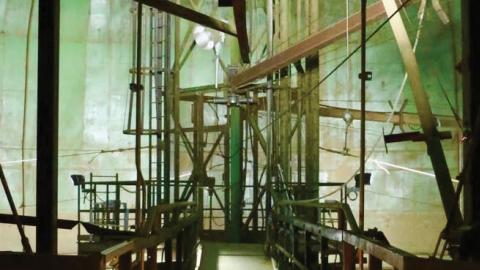In a memorandum released Monday, Secretary of Defense Lloyd Austin announced the planned closure of Red Hill, the U.S. military’s most important fuel farm in the Indo-Pacific, and expressed interest in expanding and accelerating a transition toward more “dispersed fueling at sea and ashore.” Coming in the wake of a fuel leak crisis at the Hawaiian facility, shutting Red Hill’s fuel stores is straightforward, but shifting to a resilient fuel architecture will require continued leadership and major investments.
Russia’s invasion of Ukraine has starkly illustrated how operations can stumble with inadequate logistics and infrastructure. In the Indo-Pacific, China will critically examine whether the U.S. Department of Defense’s (DoD) Red Hill announcement will be followed by significant new initiatives that address gaps and provide U.S. commanders with novel options or only exacerbates problems in an already vulnerable force. To evolve from today’s brittle fuel architecture to a resilient one, DoD should urgently pursue three classes of initiatives.
First, DoD will need to increase the distribution and protection of its fuel stocks on land. Hardened underground fuel stores were necessary in 1943 when construction at Red Hill started and given even more potent Chinese and Russian missile threats. They are still necessary today. DoD should build new hardened underground fuel stores in other locations throughout the Indo-Pacific, such as Alaska, the Marianas, Compact of Free Association States, and Australia. These stores would complement or replace planned DoD projects that are constructing vulnerable, aboveground stores in places like Darwin and Tinian.
Though costly, hardened underground fuel stores smaller than Red Hill would provide greater protection against attacks than aboveground or cut-and-cover fuel storage tanks and increase the likelihood U.S. military forces would have enough fuel to sustain operations at bases during a conflict. New double-hulled hardened underground storage tanks can be built in an environmentally conscious manner that allows for interstitial monitoring and maintenance.
Hardened underground fuel stores could be complemented by commercially owned and operated stores. For example, there are up to 3 million barrels of unused storage capacity in a shutdown refinery on Oahu that could be converted to provide low-cost aboveground fuel stores for DoD.
Second, DoD needs to gain assured access to more maritime tankers. Maritime tankers are essential to transport fuel from refineries to bases, refuel Navy ships at sea, and serve as floating fuel stores. Far more U.S.-flag tankers are needed. U.S. Transportation Command identified in the 2016 Mobility Capabilities Requirements Study a wartime requirement for 86 tankers; however, only about 9 U.S.-flag tankers are now available to DoD. The nascent Tanker Security Fleet program provides a stipend to 10 U.S.-flag tankers and may generate a net increase of 5 or so tankers in the U.S. fleet.
Hoping requisite numbers of foreign tankers and their crews will be available in a conflict to substitute for U.S. tankers is imprudent. Global spare tanker capacity significantly fluctuates, and a large and growing portion of commercial tanker fleets are Chinese controlled or subject to Chinese coercion or might not want to participate in a Sino-American confrontation.
DoD can rapidly increase the number of U.S.-flagged tankers in a variety of ways. The easiest and lowest-cost option is to source a greater proportion of DLA Energy bulk fuel contracts from U.S. refineries. Costing around $30 million per year (or half a cent per gallon more in terms of what the military services pay for fuel), this could increase the amount of preference cargo available to U.S.-flag tankers and expand the U.S. commercial tanker fleet by five or more tankers. Furthermore, DoD can increase the number of Tanker Security Fleet slots, increase their stipend to match the operating differential between U.S. and foreign-flag vessels, and eliminate regular Tanker Security Fleet participants’ access to preference cargo fuel to have these tankers operate in international trade, while other U.S.-flag tankers transport preference cargo and meet domestic trade requirements. As another option, DoD can long-term charter additional tankers to serve as prepositioned reserves afloat that can move to areas of need. And lastly, the U.S. Congress could mandate a requirement that a gradually growing proportion of U.S. energy exports would need to be lifted on U.S.-flag tankers.
The third initiative DoD should pursue is more and improved fuel transfer, distribution, and reconstitution capabilities. DoD only has one operational expeditionary system that using pumps and hoses can rapidly transfer fuel from maritime tankers to forces ashore and eight other lower-throughput systems. This is not enough to support distributed operations within the Indo-Pacific, much less globally. Moreover, DoD’s ability to rapidly repair attacks to its fuel stores and distribution systems is modest and needs major enhancements. Similarly, improved interconnectedness with allies in countries like Japan and Korea through the crosslinking of fuel tanks at neighboring bases, joint contracts, and other measures could also boost the resilience of allied military fueling architectures.
Secretary Austin’s commitment to steward the environment and protect our citizens should be commended. Moving forward, we should see an equally serious commitment to shift to a resilient fuel architecture. Signs of this shift in the forthcoming President’s Budget proposal should include launching new hardened underground fuel stores construction projects, establishing complementary commercially owned and operated fuel stores, changing DLA Energy fuel sourcing, gaining assured access to U.S.-flag tankers through an expanded and reformed Tanker Security Fleet and more chartered tankers, and investments in new over-the-shore fuel transfer, distribution, and reconstitution capabilities.
If Red Hill’s fuel gets equally divided into new hardened underground storage tanks, existing commercially owned and operated stores, and chartered maritime tankers, and if DoD buys redundant sets of over-the-shore fuel transfer systems for two sites (as shown in the figure below), simply replacing Red Hill’s reserves could cost about $3.9 billion in upfront costs and $11 billion over 30 years—similar to the $10 billion estimated as necessary to recapitalize Red Hill. Additional investments in other logistics assets, infrastructure, and reconstitution capabilities will be necessary to allow DoD to distribute its forces across the Indo-Pacific and globally and deter adversary aggression.
These collective changes will not be cheap, but with continued senior DoD leadership and the support of Congress, the nation can clean up the fuel spill on Oahu and build from this crisis a more resilient fuel architecture.
Read in RealClear Defense

















